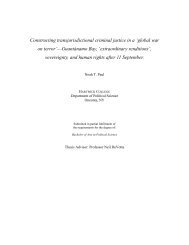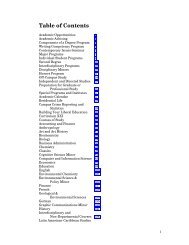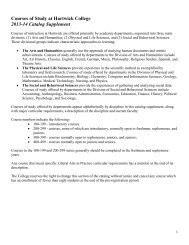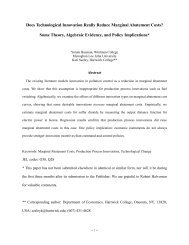The Effects of Atrazine on Tail Regeneration in ... - Hartwick College
The Effects of Atrazine on Tail Regeneration in ... - Hartwick College
The Effects of Atrazine on Tail Regeneration in ... - Hartwick College
You also want an ePaper? Increase the reach of your titles
YUMPU automatically turns print PDFs into web optimized ePapers that Google loves.
<str<strong>on</strong>g>The</str<strong>on</strong>g> <str<strong>on</strong>g>Effects</str<strong>on</strong>g> <str<strong>on</strong>g>of</str<strong>on</strong>g> <str<strong>on</strong>g>Atraz<strong>in</strong>e</str<strong>on</strong>g> <strong>on</strong> <strong>Tail</strong> Regenerati<strong>on</strong> <strong>in</strong> Salamanders<br />
Carlena K. Johns<strong>on</strong><br />
Department <str<strong>on</strong>g>of</str<strong>on</strong>g> Biology<br />
<strong>Hartwick</strong> <strong>College</strong><br />
One<strong>on</strong>ta, NY<br />
This thesis is submitted <strong>in</strong> partial satisfacti<strong>on</strong> <str<strong>on</strong>g>of</str<strong>on</strong>g> the requirements for the degree <str<strong>on</strong>g>of</str<strong>on</strong>g> Bachelor<br />
<str<strong>on</strong>g>of</str<strong>on</strong>g> Arts or Bachelor <str<strong>on</strong>g>of</str<strong>on</strong>g> Sciences from the Department <str<strong>on</strong>g>of</str<strong>on</strong>g> Biology, <strong>Hartwick</strong> <strong>College</strong>.<br />
_____________________________<br />
_______________<br />
<str<strong>on</strong>g>The</str<strong>on</strong>g>sis Advisor Date<br />
_____________________________<br />
_______________<br />
Chair, Biology Department Date<br />
<str<strong>on</strong>g>The</str<strong>on</strong>g> <str<strong>on</strong>g>Effects</str<strong>on</strong>g> <str<strong>on</strong>g>of</str<strong>on</strong>g> <str<strong>on</strong>g>Atraz<strong>in</strong>e</str<strong>on</strong>g> <strong>on</strong> <strong>Tail</strong> Regenerati<strong>on</strong> <strong>in</strong> Salamanders
Carlena Johns<strong>on</strong><br />
Dr. Stanley K. Sessi<strong>on</strong>s<br />
ABSTRACT<br />
<str<strong>on</strong>g>Atraz<strong>in</strong>e</str<strong>on</strong>g>, a widely used herbicide, is thought to be c<strong>on</strong>tribut<strong>in</strong>g to amphibian<br />
decl<strong>in</strong>es. In additi<strong>on</strong>, it may be work<strong>in</strong>g as an endocr<strong>in</strong>e disruptor <strong>in</strong> amphibians. To better<br />
understand if atraz<strong>in</strong>e affects cell proliferati<strong>on</strong> I studied the effects <str<strong>on</strong>g>of</str<strong>on</strong>g> atraz<strong>in</strong>e <strong>on</strong> divid<strong>in</strong>g<br />
cells <strong>in</strong> regenerat<strong>in</strong>g tails <str<strong>on</strong>g>of</str<strong>on</strong>g> the Red-backed Salamander (Plethod<strong>on</strong> c<strong>in</strong>ereus). It was found<br />
that there was a significant difference between the percentages <str<strong>on</strong>g>of</str<strong>on</strong>g> divid<strong>in</strong>g cells <strong>in</strong> the<br />
experimental salamanders, but not between any <str<strong>on</strong>g>of</str<strong>on</strong>g> the experimental groups and the c<strong>on</strong>trol.<br />
Specifically, the tissues appear to show a dose-dependent effect <strong>in</strong> which an <strong>in</strong>crease <strong>in</strong><br />
cellular growth was seen <strong>on</strong>ly at the lowest c<strong>on</strong>centrati<strong>on</strong>. This result is c<strong>on</strong>sistent with<br />
atraz<strong>in</strong>e act<strong>in</strong>g as an endocr<strong>in</strong>e disruptor. Dead cells were also observed <strong>in</strong> most <str<strong>on</strong>g>of</str<strong>on</strong>g> the<br />
regenerat<strong>in</strong>g tails, but were not quantified <strong>in</strong> this study. Further research should be<br />
c<strong>on</strong>ducted <strong>in</strong>to the effects <str<strong>on</strong>g>of</str<strong>on</strong>g> atraz<strong>in</strong>e <strong>on</strong> both cellular growth and cell death dur<strong>in</strong>g<br />
amphibian growth and development.<br />
INTRODUCTION<br />
Over the past decade the issue <str<strong>on</strong>g>of</str<strong>on</strong>g> decl<strong>in</strong><strong>in</strong>g amphibian populati<strong>on</strong>s has been <strong>in</strong> the<br />
forefr<strong>on</strong>t <str<strong>on</strong>g>of</str<strong>on</strong>g> both scientific and popular literature. Amphibians are important envir<strong>on</strong>mental<br />
<strong>in</strong>dicators because they have th<strong>in</strong> moist sk<strong>in</strong>, which is used as a respiratory surface, and<br />
because they lay their eggs <strong>in</strong> the water. In this way, they may be exposed to chemicals and<br />
other pollutants very easily. Also, the basic development and the immune system <str<strong>on</strong>g>of</str<strong>on</strong>g><br />
amphibians are similar to that <str<strong>on</strong>g>of</str<strong>on</strong>g> humans and other vertebrates.<br />
Many hypotheses have been suggested as to why amphibian populati<strong>on</strong>s are<br />
decl<strong>in</strong><strong>in</strong>g. Some <str<strong>on</strong>g>of</str<strong>on</strong>g> these <strong>in</strong>clude: chemical polluti<strong>on</strong>, UV radiati<strong>on</strong>, diseases, parasite, global<br />
climate change, over-collect<strong>in</strong>g and general habitat destructi<strong>on</strong>. It is very likely however that<br />
it is a comb<strong>in</strong>ati<strong>on</strong> <str<strong>on</strong>g>of</str<strong>on</strong>g> some or all <str<strong>on</strong>g>of</str<strong>on</strong>g> these, or someth<strong>in</strong>g else that has not been thought <str<strong>on</strong>g>of</str<strong>on</strong>g> yet.<br />
<str<strong>on</strong>g>The</str<strong>on</strong>g> herbicide atraz<strong>in</strong>e is the most comm<strong>on</strong> c<strong>on</strong>tam<strong>in</strong>ant <str<strong>on</strong>g>of</str<strong>on</strong>g> ground, surface, and<br />
dr<strong>in</strong>k<strong>in</strong>g water (Hayes, 2002). About 27 milli<strong>on</strong> kilograms <str<strong>on</strong>g>of</str<strong>on</strong>g> atraz<strong>in</strong>e are used each year <strong>in</strong><br />
the US, mostly <strong>in</strong> corn grow<strong>in</strong>g regi<strong>on</strong>s (Withgott, 2002). <str<strong>on</strong>g>The</str<strong>on</strong>g> EPA has set a maximum limit<br />
<str<strong>on</strong>g>of</str<strong>on</strong>g> 3 ppb atraz<strong>in</strong>e <strong>in</strong> dr<strong>in</strong>k<strong>in</strong>g water (U.S. Envir<strong>on</strong>mental Protecti<strong>on</strong> Agency (U.S. EPA),<br />
2006). It is therefore apparent that c<strong>on</strong>tam<strong>in</strong>ati<strong>on</strong> <str<strong>on</strong>g>of</str<strong>on</strong>g> ground water exists, but the<br />
c<strong>on</strong>sequences <str<strong>on</strong>g>of</str<strong>on</strong>g> this c<strong>on</strong>tam<strong>in</strong>ati<strong>on</strong> have been disputed (Coady et al., 2004; Filipov et al.,<br />
2005; Hayes, 2004). One study shows that atraz<strong>in</strong>e affects the immune systems <str<strong>on</strong>g>of</str<strong>on</strong>g> juvenile<br />
mice by adversely affect<strong>in</strong>g lymphocyte distributi<strong>on</strong> as well as decreas<strong>in</strong>g cellularity with<strong>in</strong><br />
the spleen and thymus (Filipov et al., 2005). It also shows that some effects <str<strong>on</strong>g>of</str<strong>on</strong>g> the herbicide<br />
rema<strong>in</strong> well after exposure to it has ended. A study that looked at the effects <str<strong>on</strong>g>of</str<strong>on</strong>g> atraz<strong>in</strong>e <strong>on</strong><br />
embryos and larvae c<strong>on</strong>cludes that atraz<strong>in</strong>e does not have any adverse effects <strong>on</strong> hatchability,<br />
post hatch mortality, or swimm<strong>in</strong>g speed and c<strong>on</strong>cludes that “direct toxicity <str<strong>on</strong>g>of</str<strong>on</strong>g> atraz<strong>in</strong>e is<br />
probably not a significant factor <strong>in</strong> recent amphibian decl<strong>in</strong>es” (Allran and Karasov, 2001).<br />
Another study looked at the effects <str<strong>on</strong>g>of</str<strong>on</strong>g> atraz<strong>in</strong>e <strong>on</strong> growth and g<strong>on</strong>ad development (Coady et<br />
al. 2004). Coady et al. (2004) c<strong>on</strong>clude that there is no difference <strong>in</strong> weight or length <str<strong>on</strong>g>of</str<strong>on</strong>g> the<br />
exposed vs. c<strong>on</strong>trol <strong>in</strong>dividuals and also says that there is no significant difference <strong>in</strong> the<br />
g<strong>on</strong>adal development <str<strong>on</strong>g>of</str<strong>on</strong>g> the frogs, even though multiple testes, size irregularity, and<br />
“rudimentary hermaphroditism”, <strong>in</strong>clud<strong>in</strong>g <strong>in</strong>tersex g<strong>on</strong>ads and testicular oocytes, were
observed. Other recent studies have shown that even low doses <str<strong>on</strong>g>of</str<strong>on</strong>g> atraz<strong>in</strong>e, such as those<br />
found <strong>in</strong> agricultural run<str<strong>on</strong>g>of</str<strong>on</strong>g>f, can cause adverse effects <strong>on</strong> male African clawed frogs<br />
(Xenopus laevis), such as hermaphroditism and the demasculizati<strong>on</strong> <str<strong>on</strong>g>of</str<strong>on</strong>g> the larynges <str<strong>on</strong>g>of</str<strong>on</strong>g><br />
exposed males (Hayes et al. 2003). Hayes et al. (2002), as well as others, have c<strong>on</strong>cluded<br />
that atraz<strong>in</strong>e works as an endocr<strong>in</strong>e disruptor result<strong>in</strong>g <strong>in</strong> the effects cited by these articles.<br />
Rohr et al. (2006) <strong>in</strong>vestigated possible persistent effects <str<strong>on</strong>g>of</str<strong>on</strong>g> atraz<strong>in</strong>e after exposure to the<br />
herbicide was stopped <strong>on</strong> the salamander Ambystoma barbouri. <str<strong>on</strong>g>The</str<strong>on</strong>g>y found that there was a<br />
significant difference <strong>in</strong> survival between the three experimental groups (4, 40, and 400 ppb)<br />
and the c<strong>on</strong>trol and also cite a n<strong>on</strong>-l<strong>in</strong>ear pattern <strong>in</strong> their results, which is characteristic <str<strong>on</strong>g>of</str<strong>on</strong>g> an<br />
endocr<strong>in</strong>e disruptor. A study by Storrs & Keisecker (2004) also showed a n<strong>on</strong>-l<strong>in</strong>ear rate <str<strong>on</strong>g>of</str<strong>on</strong>g><br />
survivorship dur<strong>in</strong>g a study <strong>in</strong>to the effects <str<strong>on</strong>g>of</str<strong>on</strong>g> l<strong>on</strong>g-term exposure to low levels <str<strong>on</strong>g>of</str<strong>on</strong>g> atraz<strong>in</strong>e.<br />
Brodk<strong>in</strong> et al. (2007) found that atraz<strong>in</strong>e may also work as an immune disruptor <strong>in</strong><br />
amphibians. It is obvious that there is dispute over the c<strong>on</strong>sequences <str<strong>on</strong>g>of</str<strong>on</strong>g> atraz<strong>in</strong>e <strong>on</strong><br />
amphibians, but it is clear that this issue deserves c<strong>on</strong>t<strong>in</strong>ued study to help clarify any possible<br />
effects <strong>on</strong> amphibian populati<strong>on</strong>s.<br />
Previous senior research theses (Wilkes, 2004 & Owens, 2005) have shown that<br />
atraz<strong>in</strong>e has a negative effect <strong>on</strong> growth and development, as well as the immune system. To<br />
better understand how atraz<strong>in</strong>e may cause these negative effects I choose to <strong>in</strong>vestigate the<br />
mechanism by which atraz<strong>in</strong>e works. I chose to study the effects <str<strong>on</strong>g>of</str<strong>on</strong>g> atraz<strong>in</strong>e <strong>on</strong> tail<br />
regenerati<strong>on</strong> <strong>in</strong> salamanders to see if atraz<strong>in</strong>e would affect cell proliferati<strong>on</strong> <strong>in</strong> a rapidly<br />
grow<strong>in</strong>g tissue.<br />
MATERIALS AND METHODS<br />
A total <str<strong>on</strong>g>of</str<strong>on</strong>g> 18 Red-backed salamanders (Plethod<strong>on</strong> c<strong>in</strong>ereus) were caught from the<br />
area surround<strong>in</strong>g Strawberry field (<strong>Hartwick</strong> <strong>College</strong>, One<strong>on</strong>ta NY). <str<strong>on</strong>g>The</str<strong>on</strong>g> salamanders were<br />
brought back to the lab and acclimated for <strong>on</strong>e week. Before be<strong>in</strong>g <strong>in</strong>troduced to the<br />
treatment, about half <str<strong>on</strong>g>of</str<strong>on</strong>g> each salamander’s tail was removed with a clean blade. <str<strong>on</strong>g>The</str<strong>on</strong>g><br />
salamanders were then randomly assigned <strong>on</strong>e <str<strong>on</strong>g>of</str<strong>on</strong>g> four treatment groups (0 ppb c<strong>on</strong>trol, 1ppb<br />
atraz<strong>in</strong>e, 10 ppb atraz<strong>in</strong>e, or 100 ppb atraz<strong>in</strong>e). <str<strong>on</strong>g>The</str<strong>on</strong>g> atraz<strong>in</strong>e treatment soluti<strong>on</strong>s were made<br />
from a series <str<strong>on</strong>g>of</str<strong>on</strong>g> diluti<strong>on</strong>s from a “stock” atraz<strong>in</strong>e soluti<strong>on</strong>. <str<strong>on</strong>g>The</str<strong>on</strong>g> stock soluti<strong>on</strong> <strong>in</strong>cluded<br />
ethanol to dissolve the atraz<strong>in</strong>e itself and aged tap water. <str<strong>on</strong>g>The</str<strong>on</strong>g> c<strong>on</strong>trol soluti<strong>on</strong> was made<br />
with aged tap water and the same amount <str<strong>on</strong>g>of</str<strong>on</strong>g> ethanol as the 100 ppb treatment. Each<br />
salamander was kept <strong>in</strong> a Petri dish with filter paper and 10mls <str<strong>on</strong>g>of</str<strong>on</strong>g> the assigned treatment<br />
soluti<strong>on</strong>. Three salamanders were <strong>in</strong>cluded <strong>in</strong> the 0 ppb c<strong>on</strong>trol group and five salamanders<br />
were <strong>in</strong> each <str<strong>on</strong>g>of</str<strong>on</strong>g> the three experimental atraz<strong>in</strong>e groups. <str<strong>on</strong>g>The</str<strong>on</strong>g> salamanders were kept at 15º C.<br />
New treatment soluti<strong>on</strong>s were made and replaced <strong>in</strong> each Petri dish every three days for four<br />
weeks. In additi<strong>on</strong>, each salamander was fed a few fruit flies every third day. At the end <str<strong>on</strong>g>of</str<strong>on</strong>g><br />
the exposure period, each salamander was <strong>in</strong>jected with 0.3% colchec<strong>in</strong>e twenty-five hours<br />
prior to harvest<strong>in</strong>g the tail regenerate. <str<strong>on</strong>g>The</str<strong>on</strong>g> tails were then placed <strong>in</strong> 3:1 ethanol: acetic acid<br />
fixative. <str<strong>on</strong>g>The</str<strong>on</strong>g>y were then embedded <strong>in</strong> wax, follow<strong>in</strong>g standard histological procedure, and<br />
secti<strong>on</strong>ed at 10µm. Slides were then sta<strong>in</strong>ed with hematoxyl<strong>in</strong>-eos<strong>in</strong>. <str<strong>on</strong>g>The</str<strong>on</strong>g> number <str<strong>on</strong>g>of</str<strong>on</strong>g> mitotic<br />
cells/total number <str<strong>on</strong>g>of</str<strong>on</strong>g> cells for at least 5 secti<strong>on</strong>s <str<strong>on</strong>g>of</str<strong>on</strong>g> each tail were counted and totaled to<br />
determ<strong>in</strong>e a proporti<strong>on</strong> <str<strong>on</strong>g>of</str<strong>on</strong>g> mitotic cells for each salamander tail.
RESULTS<br />
Over the four week period dur<strong>in</strong>g which tail regenerati<strong>on</strong> occurred, the average length<br />
<str<strong>on</strong>g>of</str<strong>on</strong>g> the regenerati<strong>on</strong> bud for the c<strong>on</strong>trol, 1 ppb, 10 ppb, and 100 ppb groups, respectively were:<br />
0.4cm, 0.37cm, 0.39cm, and 0.36cm. <str<strong>on</strong>g>The</str<strong>on</strong>g>re is no statistical significance between any <str<strong>on</strong>g>of</str<strong>on</strong>g> the<br />
groups regard<strong>in</strong>g regenerati<strong>on</strong> bud length. In additi<strong>on</strong>, no adverse effects <strong>on</strong> the salamanders<br />
were noted dur<strong>in</strong>g the <strong>on</strong>e m<strong>on</strong>th exposure period (such as loss <str<strong>on</strong>g>of</str<strong>on</strong>g> appetite or death). <str<strong>on</strong>g>The</str<strong>on</strong>g>re<br />
was no correlati<strong>on</strong> between the amount <str<strong>on</strong>g>of</str<strong>on</strong>g> growth <str<strong>on</strong>g>of</str<strong>on</strong>g> the regenerati<strong>on</strong> bud and the<br />
c<strong>on</strong>centrati<strong>on</strong> <str<strong>on</strong>g>of</str<strong>on</strong>g> atraz<strong>in</strong>e. In additi<strong>on</strong>, there is no correlati<strong>on</strong> between the amount <str<strong>on</strong>g>of</str<strong>on</strong>g> growth<br />
and the proporti<strong>on</strong> <str<strong>on</strong>g>of</str<strong>on</strong>g> divid<strong>in</strong>g cells. For each tail, 5-9 secti<strong>on</strong>s were used to record the<br />
proporti<strong>on</strong> <str<strong>on</strong>g>of</str<strong>on</strong>g> mitotic cells (Fig. 1). Only <strong>on</strong>e tail (<strong>in</strong> the 10 ppb treatment group) used five<br />
secti<strong>on</strong>s, while most tails c<strong>on</strong>ta<strong>in</strong>ed six secti<strong>on</strong>s from which data was recorded. <str<strong>on</strong>g>The</str<strong>on</strong>g> number<br />
<str<strong>on</strong>g>of</str<strong>on</strong>g> mitotic cells per secti<strong>on</strong> were counted (Fig. 2) and the total for each secti<strong>on</strong> were added<br />
together to give a total number <str<strong>on</strong>g>of</str<strong>on</strong>g> mitotic cells for a given tail. In the same manner, the total<br />
number <str<strong>on</strong>g>of</str<strong>on</strong>g> cells per secti<strong>on</strong> were counted and added together for a total number <str<strong>on</strong>g>of</str<strong>on</strong>g> cells for a<br />
given tail. <str<strong>on</strong>g>The</str<strong>on</strong>g> proporti<strong>on</strong> <str<strong>on</strong>g>of</str<strong>on</strong>g> mitotic cells was calculated from this data (Table 1).<br />
Figure 1. This shows two cells undergo<strong>in</strong>g mitosis (arrows). Hematoxyl<strong>in</strong><br />
and eos<strong>in</strong> sta<strong>in</strong><strong>in</strong>g <str<strong>on</strong>g>of</str<strong>on</strong>g> 10 micrometer paraff<strong>in</strong> secti<strong>on</strong>.
6.000<br />
Mean Proporti<strong>on</strong> <str<strong>on</strong>g>of</str<strong>on</strong>g> mitotic cells<br />
5.000<br />
4.000<br />
3.000<br />
2.000<br />
1.000<br />
0.000<br />
C<strong>on</strong>trol<br />
1 ppb<br />
10 ppb<br />
<str<strong>on</strong>g>Atraz<strong>in</strong>e</str<strong>on</strong>g> C<strong>on</strong>centrati<strong>on</strong><br />
Error bars: 95% CI<br />
100 ppb<br />
Figure 2. This shows the average proporti<strong>on</strong> <str<strong>on</strong>g>of</str<strong>on</strong>g> mitotic cells for each<br />
treatment group. Note that there is a significant difference between the<br />
experimental groups 1 ppb & 10 ppb.<br />
Table 1. This shows each <strong>in</strong>dividual used <strong>in</strong> the four treatment groups. Each <strong>in</strong>dividual is<br />
separated <strong>in</strong>to the total number <str<strong>on</strong>g>of</str<strong>on</strong>g> mitotic cells, total number <str<strong>on</strong>g>of</str<strong>on</strong>g> cells <strong>in</strong> the tail and the<br />
proporti<strong>on</strong> <str<strong>on</strong>g>of</str<strong>on</strong>g> mitotic cells found for each tail. <str<strong>on</strong>g>The</str<strong>on</strong>g> total mitotic cells and the total cells were<br />
found by add<strong>in</strong>g the numbers for each secti<strong>on</strong> <str<strong>on</strong>g>of</str<strong>on</strong>g> a given tail.<br />
Treatment Total Mitotic cells Total cells Proporti<strong>on</strong> <str<strong>on</strong>g>of</str<strong>on</strong>g> mitotic cells<br />
C<strong>on</strong>trol 171 4878 3.506<br />
224 7961 2.814<br />
252 6319 3.988<br />
1 ppb 257 4974 5.167<br />
135 3411 3.958<br />
310 6894 4.497<br />
295 6670 4.423<br />
392 12164 3.223<br />
10 ppb 153 6268 2.441<br />
200 5941 3.366<br />
155 5909 2.623<br />
186 12317 1.51<br />
100 ppb 213 8055 2.644<br />
163 6095 2.674<br />
246 8152 3.018<br />
349 8313 4.194<br />
213 6779 3.142<br />
One tail from the 10 ppb experimental group was not <strong>in</strong>cluded <strong>in</strong> data analysis due to<br />
poor histology and a resultant <strong>in</strong>accuracy <strong>in</strong> count<strong>in</strong>g cells. This reduced the number <str<strong>on</strong>g>of</str<strong>on</strong>g> tails<br />
<strong>in</strong> the 10 ppb group to four, as compared to the 1 ppb and 100 ppb experimental groups<br />
which c<strong>on</strong>ta<strong>in</strong> five tails each. Overall, it is apparent that the proporti<strong>on</strong> <str<strong>on</strong>g>of</str<strong>on</strong>g> mitotic cells is<br />
largest at the 1 ppb c<strong>on</strong>centrati<strong>on</strong> <str<strong>on</strong>g>of</str<strong>on</strong>g> atraz<strong>in</strong>e, while it is smallest at the 10 ppb c<strong>on</strong>centrati<strong>on</strong><br />
<str<strong>on</strong>g>of</str<strong>on</strong>g> atraz<strong>in</strong>e (Fig. 2, Table 2). A <strong>on</strong>e-way ANOVA was preformed <strong>on</strong> the data and the results
were found to be significant (F 3,13 = 5.192, P = 0.014). Afterwards, post hoc tests (LSD,<br />
SNK, b<strong>on</strong>ferr<strong>on</strong>i, and tukey) were preformed <strong>on</strong> the data to f<strong>in</strong>d which treatments were<br />
significantly different. It was found that there was a statistically significant difference<br />
between the 1 ppb and 10 ppb treatment groups <strong>on</strong>ly. <str<strong>on</strong>g>The</str<strong>on</strong>g>re was no difference between any<br />
<str<strong>on</strong>g>of</str<strong>on</strong>g> the experimental treatment groups and the c<strong>on</strong>trol.<br />
Table 2. This table shows the average proporti<strong>on</strong> <str<strong>on</strong>g>of</str<strong>on</strong>g> mitotic cells<br />
for each treatment group. Note that there is a significant difference<br />
between the experimental groups 1 ppb & 10 ppb.<br />
Treatment<br />
Mean Proporti<strong>on</strong> <str<strong>on</strong>g>of</str<strong>on</strong>g> Mitotic<br />
Cells<br />
C<strong>on</strong>trol 3.44 ± 0.59<br />
1 ppb 4.25 ± 0.72<br />
10 ppb 2.49 ± 0.76<br />
100 ppb 3.14 ± 0.63<br />
DISCUSSION<br />
Overall, atraz<strong>in</strong>e appears to have little or no effect <strong>on</strong> cell proliferati<strong>on</strong> <strong>in</strong><br />
regenerat<strong>in</strong>g salamander tails. <str<strong>on</strong>g>The</str<strong>on</strong>g>re may be a small dose dependent effect (as seen by the<br />
significance between the 1 ppb and 10 ppb experimental groups), which is characteristic <str<strong>on</strong>g>of</str<strong>on</strong>g><br />
an endocr<strong>in</strong>e disruptor. This is c<strong>on</strong>sistent with other research that c<strong>on</strong>cludes that atraz<strong>in</strong>e<br />
works as an endocr<strong>in</strong>e disruptor (Hayes et al. 2002, Sessi<strong>on</strong>s et al. unpublished). It is also<br />
important to note the high degree <str<strong>on</strong>g>of</str<strong>on</strong>g> variance with<strong>in</strong> the c<strong>on</strong>trol. Due to the variance with<strong>in</strong><br />
the c<strong>on</strong>trol, a possible pattern may have been masked. Further steps should be taken to better<br />
understand if atraz<strong>in</strong>e has an effect <strong>on</strong> cell proliferati<strong>on</strong> before it is ruled out as the<br />
mechanism by which the herbicide is functi<strong>on</strong><strong>in</strong>g. Other protocols, such as the use <str<strong>on</strong>g>of</str<strong>on</strong>g> BrdU<br />
to label mitotic cells, may prove to be a better measure <str<strong>on</strong>g>of</str<strong>on</strong>g> mitotic activity, though<br />
prelim<strong>in</strong>ary tests show that background sta<strong>in</strong><strong>in</strong>g may be an issue that would need to be<br />
resolved to get an accurate count <str<strong>on</strong>g>of</str<strong>on</strong>g> cells. I also propose that similar studies should be<br />
c<strong>on</strong>ducted <strong>on</strong> frogs to rule out the possibility <str<strong>on</strong>g>of</str<strong>on</strong>g> a species-specific reacti<strong>on</strong> to salamanders<br />
that may not be applicable to amphibians as a whole (though Rohr et al., 2006, showed that<br />
atraz<strong>in</strong>e does have a negative effect <strong>on</strong> salamanders exposed to the chemical before<br />
metamorphosis).<br />
In additi<strong>on</strong>, it was noted that many <str<strong>on</strong>g>of</str<strong>on</strong>g> the tail secti<strong>on</strong>s c<strong>on</strong>ta<strong>in</strong>ed dead or dy<strong>in</strong>g cells.<br />
<str<strong>on</strong>g>The</str<strong>on</strong>g> proporti<strong>on</strong> <str<strong>on</strong>g>of</str<strong>on</strong>g> dy<strong>in</strong>g cells was not quantified at this time, but the possible <strong>in</strong>terrelated<br />
effects <str<strong>on</strong>g>of</str<strong>on</strong>g> atraz<strong>in</strong>e <strong>on</strong> cell proliferati<strong>on</strong> and dy<strong>in</strong>g cells should be looked at <strong>in</strong> future research.<br />
Studies should be d<strong>on</strong>e to determ<strong>in</strong>e the extent to which atraz<strong>in</strong>e may simply be caus<strong>in</strong>g too<br />
much cell death and the possible effect that cell death may have <strong>on</strong> <strong>in</strong>creas<strong>in</strong>g the rate <str<strong>on</strong>g>of</str<strong>on</strong>g><br />
mitosis, especially at low levels.
It is important to c<strong>on</strong>sider the mechanism by which atraz<strong>in</strong>e may be caus<strong>in</strong>g the<br />
adverse effects that many studies have found <strong>on</strong> amphibians because by better understand<strong>in</strong>g<br />
how this herbicide stunts growth and development and the immune system we may be able to<br />
better understand the complex mixture <str<strong>on</strong>g>of</str<strong>on</strong>g> issues that may be c<strong>on</strong>tribut<strong>in</strong>g to amphibian<br />
decl<strong>in</strong>es. For example, a reducti<strong>on</strong> <strong>in</strong> the ability <str<strong>on</strong>g>of</str<strong>on</strong>g> the immune system to functi<strong>on</strong> properly<br />
may make it easier for parasites/fungi/diseases to <strong>in</strong>fect amphibians, thus caus<strong>in</strong>g a higher<br />
death rate <strong>in</strong> a populati<strong>on</strong> exposed to atraz<strong>in</strong>e than <strong>on</strong>e that was not exposed to the chemical.<br />
Only by better understand<strong>in</strong>g how <strong>in</strong>dividual causes may be negatively affect<strong>in</strong>g amphibian<br />
populati<strong>on</strong>s can we beg<strong>in</strong> to understand the entire scope <str<strong>on</strong>g>of</str<strong>on</strong>g> these effects, not <strong>on</strong>ly <strong>on</strong><br />
amphibians, but also so that we may apply this understand<strong>in</strong>g to other species that are<br />
decl<strong>in</strong><strong>in</strong>g.<br />
ACKNOWLEDGEMENTS<br />
I would like to thank Megan Irland and Nancy Johns<strong>on</strong> for giv<strong>in</strong>g me advice and<br />
assist<strong>in</strong>g me with my research, Dr. Mary Allen for her assistance with statistics, and Dr. Stan<br />
Sessi<strong>on</strong>s for all <str<strong>on</strong>g>of</str<strong>on</strong>g> his help with my senior research project. I would like to dedicate my<br />
research to my grandmother, Betty I. Laitsch, who’s never end<strong>in</strong>g dedicati<strong>on</strong> to animals and<br />
the envir<strong>on</strong>ment has <strong>in</strong>spired me to c<strong>on</strong>t<strong>in</strong>ue my career <strong>in</strong> scientific research.<br />
LITERATURE CITED<br />
Allran, John W., William H. Karasov. 2001. <str<strong>on</strong>g>Effects</str<strong>on</strong>g> <str<strong>on</strong>g>of</str<strong>on</strong>g> <str<strong>on</strong>g>Atraz<strong>in</strong>e</str<strong>on</strong>g> <strong>on</strong> Embryos, Larvae, and<br />
Adults <str<strong>on</strong>g>of</str<strong>on</strong>g> Anuran Amphibians. Envir<strong>on</strong>mental Toxicology and Chemistry. 20(4):769-<br />
775.<br />
Brodk<strong>in</strong>, Marc A., Hareth Madhoun, Muthuramanan Rameswaran, and Itzick Vatnick. 2007.<br />
<str<strong>on</strong>g>Atraz<strong>in</strong>e</str<strong>on</strong>g> is an Immune Disruptor <strong>in</strong> Northern Leopard Frogs (Rana pipiens).<br />
Envir<strong>on</strong>mental Toxicology and Chemistry. 26(1): 80-84.<br />
Coady, Kather<strong>in</strong>e K., Margaret B. Murphy, Daniel L. Villeneuve, Markus Hecker, Paul D.<br />
J<strong>on</strong>es, James A. Carr, Keith R. Solom<strong>on</strong>, Ernest E. Smith, Glen Van Der Kraak,<br />
R<strong>on</strong>ald J. Kendall, John P. Giesy. 2004. <str<strong>on</strong>g>Effects</str<strong>on</strong>g> <str<strong>on</strong>g>of</str<strong>on</strong>g> <str<strong>on</strong>g>Atraz<strong>in</strong>e</str<strong>on</strong>g> <strong>on</strong> Metamorphosis,<br />
Growth, and G<strong>on</strong>adal Development <strong>in</strong> the Green Frog (Rana clamitans). Journal <str<strong>on</strong>g>of</str<strong>on</strong>g><br />
Toxicology and Envir<strong>on</strong>mental Health. 67:941-957.<br />
Filipov , Nikolay M., Lesya M. P<strong>in</strong>chuk, Bobbie L. Boyd and Patrick L. Crittenden. 2005.<br />
Immunotoxic <str<strong>on</strong>g>Effects</str<strong>on</strong>g> <str<strong>on</strong>g>of</str<strong>on</strong>g> Short-term <str<strong>on</strong>g>Atraz<strong>in</strong>e</str<strong>on</strong>g> Exposure <strong>in</strong> Young Male C57BL/6<br />
Mice. Toxicological Sciences. 86(2):324-332.<br />
Hayes, Tyr<strong>on</strong>e. 2002. Fem<strong>in</strong>izati<strong>on</strong> <str<strong>on</strong>g>of</str<strong>on</strong>g> Male Frogs <strong>in</strong> the Wild. Nature. 419(6910):895-896.<br />
Hayes, Tyr<strong>on</strong>e, Kelley Hast<strong>on</strong>, Mabel Tsui, Anhthu Hoang, Cathryn Haeffele, and Aar<strong>on</strong><br />
V<strong>on</strong>k. 2003. <str<strong>on</strong>g>Atraz<strong>in</strong>e</str<strong>on</strong>g>-Induced Hermaphroditism at 0.1 ppb <strong>in</strong> American Leopard<br />
Frogs (Rana pipiens): Laboratory and Field Evidence. Envir<strong>on</strong>mental Health<br />
Perspectives. 111(4): 568-575.<br />
Hayes, Tyr<strong>on</strong>e B., Atif Coll<strong>in</strong>s, Melissa Lee, Magdelena Mendoza, Nigel Noriega, A. Ali<br />
Stuart, Aar<strong>on</strong> V<strong>on</strong>k. 2002. Hermaphroditic, Demasculized Frogs After Exposure to<br />
the Herbicide <str<strong>on</strong>g>Atraz<strong>in</strong>e</str<strong>on</strong>g> At Low Ecologically Relevant Doses. Procedd<strong>in</strong>gs <str<strong>on</strong>g>of</str<strong>on</strong>g> the<br />
Nati<strong>on</strong>al Academy <str<strong>on</strong>g>of</str<strong>on</strong>g> Sciences. 99:5476-5480.
Owens, Clarence. 2005. Endocr<strong>in</strong>e Disruptors <strong>in</strong> Amphibians and Mammals: Analysis <str<strong>on</strong>g>of</str<strong>on</strong>g> the<br />
<str<strong>on</strong>g>Effects</str<strong>on</strong>g> <str<strong>on</strong>g>of</str<strong>on</strong>g> Two Comm<strong>on</strong> Envir<strong>on</strong>mental Pollutants. Journal <str<strong>on</strong>g>of</str<strong>on</strong>g> Biological Research:<br />
Senior Research <str<strong>on</strong>g>The</str<strong>on</strong>g>ses, Department <str<strong>on</strong>g>of</str<strong>on</strong>g> Biology, <strong>Hartwick</strong> <strong>College</strong>. VI(May 2005):<br />
105-112.<br />
Rohr, Jas<strong>on</strong> R., Tyler Sager, Timothy M. Sesterhenn, and Brent D. Palmer. 2006. Exposure,<br />
Postexposure, and Density-Mediated <str<strong>on</strong>g>Effects</str<strong>on</strong>g> <str<strong>on</strong>g>of</str<strong>on</strong>g> <str<strong>on</strong>g>Atraz<strong>in</strong>e</str<strong>on</strong>g> <strong>on</strong> Amphibians: Break<strong>in</strong>g<br />
Down New <str<strong>on</strong>g>Effects</str<strong>on</strong>g> <strong>in</strong>to <str<strong>on</strong>g>The</str<strong>on</strong>g>ir Parts. Envir<strong>on</strong>mental Health Perspectives. 114(1): 46-<br />
50.<br />
Storrs, Sara I. and Joseph M. Kiesecker. 2004. Survivorship Patterns <str<strong>on</strong>g>of</str<strong>on</strong>g> Larval Amphibians<br />
Exposed to Low C<strong>on</strong>centrati<strong>on</strong>s <str<strong>on</strong>g>of</str<strong>on</strong>g> <str<strong>on</strong>g>Atraz<strong>in</strong>e</str<strong>on</strong>g>. Envir<strong>on</strong>mental Health Perspectives.<br />
112(10): 1054-1057.<br />
U.S. EPA (U.S. Envir<strong>on</strong>mental Protecti<strong>on</strong> Agency). 2006. 2006 Editi<strong>on</strong> <str<strong>on</strong>g>of</str<strong>on</strong>g> the Dr<strong>in</strong>k<strong>in</strong>g<br />
Water Standards and Health Advisories. EPA 822-R-06-013. Wash<strong>in</strong>gt<strong>on</strong>, DC: U.S.<br />
Envir<strong>on</strong>mental Protecti<strong>on</strong> Agency.<br />
Wilkes, Tara. 2004. <str<strong>on</strong>g>The</str<strong>on</strong>g> <str<strong>on</strong>g>Effects</str<strong>on</strong>g> <str<strong>on</strong>g>of</str<strong>on</strong>g> the Chemical Pollutant <str<strong>on</strong>g>Atraz<strong>in</strong>e</str<strong>on</strong>g> <strong>on</strong> the Immune System<br />
<str<strong>on</strong>g>of</str<strong>on</strong>g> the Amphibian, Rana pipiens. Journal <str<strong>on</strong>g>of</str<strong>on</strong>g> Biological Research: Senior Research<br />
<str<strong>on</strong>g>The</str<strong>on</strong>g>ses, Department <str<strong>on</strong>g>of</str<strong>on</strong>g> Biology, <strong>Hartwick</strong> <strong>College</strong>. V(May 2004): 207-214.<br />
Withgott, Jay. 2002. Ubiquitous herbicide Emasculates Frogs. Science. 296(5567):447-448.

















